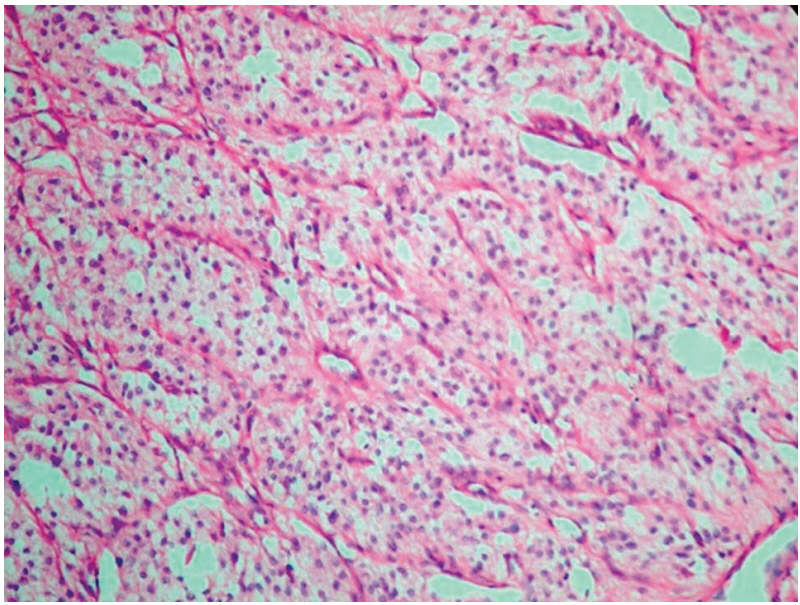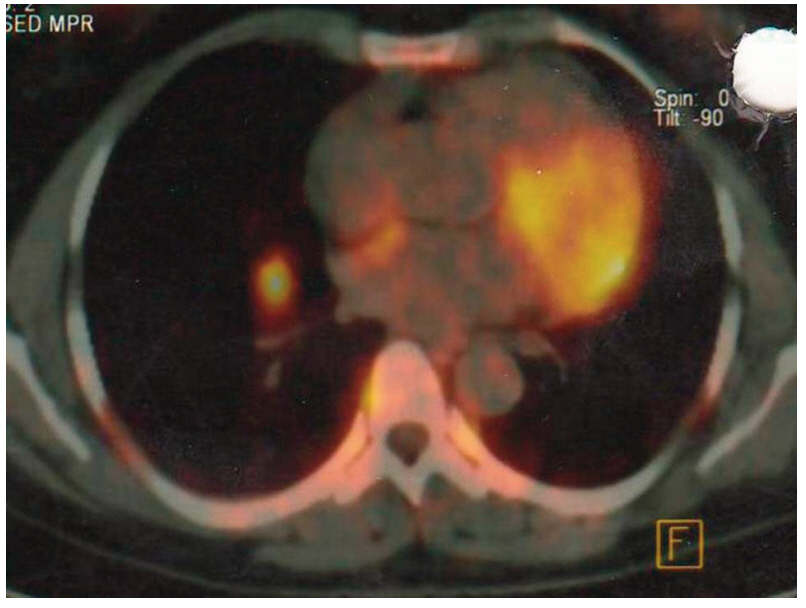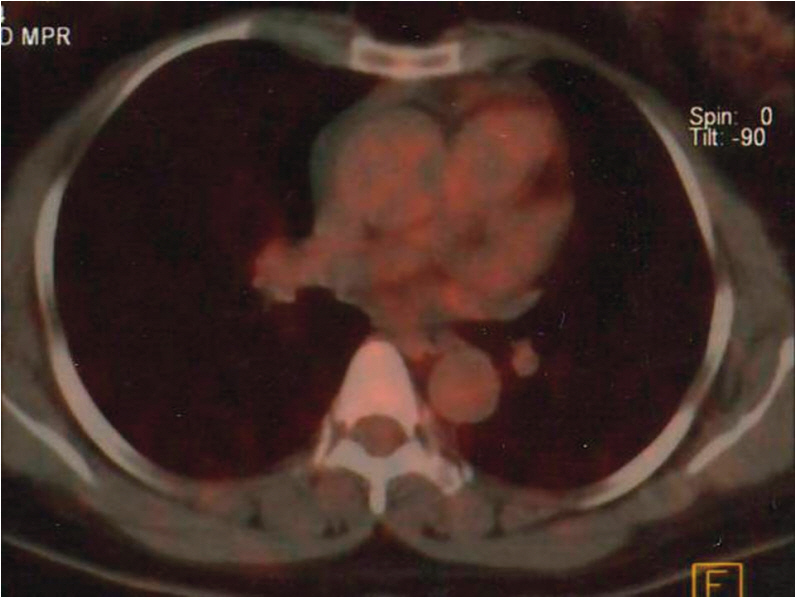Cancer Res Treat.
2014 Oct;46(4):411-414. 10.4143/crt.2013.093.
A New Approach to the Treatment of Metastatic Paraganglioma: Sorafenib
- Affiliations
-
- 1Department of Medical Oncology, University of Cukurova Faculty of Medicine, Adana, Turkey. meralgunaldi@gmail.com
- 2Department of Pathology, University of Cukurova Faculty of Medicine, Adana, Turkey.
- KMID: 2380379
- DOI: http://doi.org/10.4143/crt.2013.093
Abstract
- Paragangliomas are relatively rare chromaffin cell tumors which may be cured through resection. Patients with paragangliomas may develop metastatic diseases. There is no consensus regarding refractory chemotherapy for treatment of metastatic disease. In this report, we presented a case of a 43-year-old woman who was admitted to the hospital with a history of episodic headaches, diaphoresis, and weakness. Elevated plasma catecholamine levels and a right paraaortic mass were observed on computed tomography. The mass was excised, and a diagnosis of paraganglioma was confirmed. After 20 months of follow-up, local recurrence and metastases were detected in the thorax, abdomen, and skeletal system. Plasma and urinary catecholamine levels were high. Chemotherapy was administered, and no improvement was observed. Therefore, following this palliative conventional chemotherapy, sorafenib was administered for three months, and, finally, positron emission tomography showed that the patient's lesions had completely regressed.
Keyword
MeSH Terms
Figure
Reference
-
References
1. Frankel F. Ein Fall von doppelseitigem, vollig latent verlaufenen Nebennierentumor und gleichzeitiger Nephritis mit Veranderungen am Circulationsapparat und Retinitis. Virchows Arch. 1886; 103:244–63.2. Fliedner SM, Lehnert H, Pacak K. Metastatic paraganglioma. Semin Oncol. 2010; 37:627–37.
Article3. Krawczyk A, Hasse-Lazar K, Pawlaczek A, Szpak-Ulczok S, Krajewska J, Paliczka-Cieslak E, et al. Germinal mutations of RET, SDHB, SDHD, and VHL genes in patients with apparently sporadic pheochromocytomas and paragangliomas. Endokrynol Pol. 2010; 61:43–8.4. O’Riordain DS, Young WF Jr, Grant CS, Carney JA, van Heerden JA. Clinical spectrum and outcome of functional extraadrenal paraganglioma. World J Surg. 1996; 20:916–21.5. Lehnert H, Mundschenk J, Hahn K. Malignant pheochromocytoma. Front Horm Res. 2004; 31:155–62.
Article6. Zografos GN, Vasiliadis G, Farfaras AN, Aggeli C, Digalakis M. Laparoscopic surgery for malignant adrenal tumors. JSLS. 2009; 13:196–202.7. Kulke MH, Stuart K, Enzinger PC, Ryan DP, Clark JW, Muzikansky A, et al. Phase II study of temozolomide and thalidomide in patients with metastatic neuroendocrine tumors. J Clin Oncol. 2006; 24:401–6.
Article8. Joshua AM, Ezzat S, Asa SL, Evans A, Broom R, Freeman M, et al. Rationale and evidence for sunitinib in the treatment of malignant paraganglioma/pheochromocytoma. J Clin Endocrinol Metab. 2009; 94:5–9.
Article9. Jimenez C, Cabanillas ME, Santarpia L, Jonasch E, Kyle KL, Lano EA, et al. Use of the tyrosine kinase inhibitor sunitinib in a patient with von Hippel-Lindau disease: targeting angiogenic factors in pheochromocytoma and other von Hippel-Lindau disease-related tumors. J Clin Endocrinol Metab. 2009; 94:386–91.
Article10. Park KS, Lee JL, Ahn H, Koh JM, Park I, Choi JS, et al. Sunitinib, a novel therapy for anthracycline- and cisplatin-refractory malignant pheochromocytoma. Jpn J Clin Oncol. 2009; 39:327–31.
Article11. Cirillo F. Metastatic paraganglioma and treatment with sunitinib: a case report. Tumori. 2010; 96:1022–7.
Article12. Druce MR, Kaltsas GA, Fraenkel M, Gross DJ, Grossman AB. Novel and evolving therapies in the treatment of malignant phaeochromocytoma: experience with the mTOR inhibitor everolimus (RAD001). Horm Metab Res. 2009; 41:697–702.
Article13. Gross DJ, Munter G, Bitan M, Siegal T, Gabizon A, Weitzen R, et al. The role of imatinib mesylate (Glivec) for treatment of patients with malignant endocrine tumors positive for c-kit or PDGF-R. Endocr Relat Cancer. 2006; 13:535–40.
Article
- Full Text Links
- Actions
-
Cited
- CITED
-
- Close
- Share
- Similar articles
-
- Plasmacytoma to the Axis Mimicking Metastatic Paraganglioma: Circumferential Reconstruction via Posterior Approach
- Recurrent Hypoglycemia Triggered by Sorafenib Therapy in a Patient with Hemangiopericytoma
- A Case of a Patient with Hepatocellular Carcinoma and Lung Metastasis Who Failed Sorafenib Treatment and Achieved Complete Remission after Lung Resection and Radiation Therapy
- Sorafenib (Nexavar(R), BAY 43-9006)-induced Hand-foot Skin Reaction with Facial Erythema
- Treatments Other than Sorafenib for Patients with Advanced Hepatocellular Carcinoma




